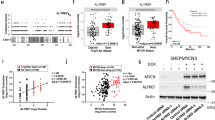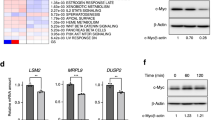Abstract
Multiple tumorigenic pathways converge on the activating protein-1 (AP-1) family of dimeric transcription complexes by affecting transcription, mRNA decay, posttranslational modifications, as well as stability of its JUN and FOS components. Several mechanisms have been implicated in the phosphorylation- and ubiquitylation-dependent control of c-Jun protein stability. Although its dimer composition has a major role in the regulation of AP-1, little is known about the influence of heterodimerization partners on the half-life of c-Jun. The FOS family member Fra-1 is overexpressed in various tumors and cancer cell lines wherein it controls motility, invasiveness, cell survival and cell division. Oncogene-induced accumulation of Fra-1 results from both increased transcription and phosphorylation-dependent stabilization of the protein. In this report, we describe a novel role of Fra-1 as a posttranslational regulator of c-Jun. By using both constitutively and inducible transformed rat thyroid cell lines, we found that c-Jun is stabilized in response to RAS oncoprotein expression. This stabilization requires the activity of the extracellular signal-related kinase (ERK) pathway, along with c-Jun heterodimerization with Fra-1. In particular, heterodimerization with Fra-1 inhibits c-Jun breakdown by a mechanism dependent on the phosphorylation of the Fra-1 C-terminal domain that positively controls the stability of the protein in response to ERK signaling. Therefore, Fra-1 modulates AP-1 dimer composition by promoting the accumulation of c-Jun in response to oncogenic RAS signaling.
This is a preview of subscription content, access via your institution
Access options
Subscribe to this journal
Receive 50 print issues and online access
$259.00 per year
only $5.18 per issue
Buy this article
- Purchase on Springer Link
- Instant access to full article PDF
Prices may be subject to local taxes which are calculated during checkout




Similar content being viewed by others
References
Adiseshaiah P, Li J, Vaz M, Kalvakolanu DV, Reddy SP . (2008). ERK signaling regulates tumor promoter induced c-Jun recruitment at the Fra-1 promoter. Biochem Biophys Res Commun 371: 304–308.
Bahassi el M, Karyala S, Tomlinson CR, Sartor MA, Medvedovic M, Hennigan RF . (2004). Critical regulation of genes for tumor cell migration by AP-1. Clin Exp Metastasis 21: 293–304.
Bakiri L, Matsuo K, Wisniewska M, Wagner E, Yaniv M . (2002). Promoter specificity and biological activity of tethered AP-1 dimers. Mol Cell Biol 22: 4952–4964.
Basbous J, Chalbos D, Hipskind R, Jariel-Encontre I, Piechaczyk M . (2007). Ubiquitin-independent proteasomal degradation of Fra-1 is antagonized by Erk1/2 pathway-mediated phosphorylation of a unique C-terminal destabilizer. Mol Cell Biol 27: 3936–3950.
Belguise K, Kersual N, Galtier F, Chalbos D . (2005). FRA-1 expression level regulates proliferation and invasiveness of breast cancer cells. Oncogene 24: 1434–1444.
Bergers G, Graninger P, Braselmann S, Wrighton C, Busslinger M . (1995). Transcriptional activation of the fra-1 gene by AP-1 is mediated by regulatory sequences in the first intron. Mol Cell Biol 15: 3748–3758.
Bossis G, Ferrara P, Acquaviva C, Jariel-Encontre I, Piechaczyk M . (2003). c-Fos proto-oncoprotein is degraded by the proteasome independently of its own ubiquitinylation in vivo. Mol Cell Biol 23: 7425–7436.
Casalino L, Bakiri L, Talotta F, Weitzman J, Fusco A, Yaniv M et al. (2007). Fra-1 promotes growth and survival in RAS-transformed thyroid cells by controlling cyclin a transcription. EMBO J 26: 1878–1890.
Casalino L, De Cesare D, Verde P . (2003). Accumulation of Fra-1 in ras-transformed cells depends on both transcriptional autoregulation and MEK-dependent posttranslational stabilization. Mol Cell Biol 23: 4401–4415.
Chinenov Y, Kerppola TK . (2001). Close encounters of many kinds: Fos-Jun interactions that mediate transcription regulatory specificity. Oncogene 20: 2438–2452.
De Vita G, Bauer L, da Costa VM, De Felice M, Baratta MG, De Menna M et al. (2004). Dose-dependent inhibition of thyroid differentiation by RAS oncogenes. Mol Endocrinol 19: 76–89.
Debinski W, Gibo DM . (2005). Fos-related antigen 1 modulates malignant features of glioma cells. Mol Cancer Res 3: 237–249.
Eferl R, Wagner E . (2003). AP-1: a double-edged sword in tumorigenesis. Nat Rev Cancer 3: 859–868.
Ferrara P, Andermarcher E, Bossis G, Acquaviva C, Brockly F, Jariel-Encontre I et al. (2003). The structural determinants responsible for c-Fos protein proteasomal degradation differ according to the conditions of expression. Oncogene 22: 1461–1474.
Fuchs SY, Dolan L, Davis RJ, Ronai Z . (1996). Phosphorylation-dependent targeting of c-Jun ubiquitination by Jun N-kinase. Oncogene 13: 1531–1535.
Fuchs SY, Ronai Z . (1999). Ubiquitination and degradation of ATF2 are dimerization dependent. Mol Cell Biol 19: 3289–3298.
Gao M, Labuda T, Xia Y, Gallagher E, Fang D, Liu YC et al. (2004). Jun turnover is controlled through JNK-dependent phosphorylation of the E3 ligase Itch. Science 306: 271–275.
Kallunki T, Deng T, Hibi M, Karin M . (1996). c-Jun can recruit JNK to phosphorylate dimerization partners via specific docking interactions. Cell 87: 929–939.
Kustikova O, Kramerov D, Grigorian M, Berezin V, Bock E, Lukanidin E et al. (1998). Fra-1 induces morphological transformation and increases in vitro invasiveness and motility of epithelioid adenocarcinoma cells. Mol Cell Biol 18: 7095–7105.
Liu H, Deng X, Shyu YJ, Li JJ, Taparowsky EJ, Hu CD . (2006). Mutual regulation of c-Jun and ATF2 by transcriptional activation and subcellular localization. EMBO J 25: 1058–1069.
Malnou CE, Salem T, Brockly F, Wodrich H, Piechaczyk M, Jariel-Encontre I . (2007). Heterodimerization with Jun family members regulates c-Fos nucleocytoplasmic traffic. J Biol Chem 282: 31046–31059.
Malnou CE, Brockly F, Favard C, Moquet-Torcy G, Piechaczyk M, Jariel-Encontre I . (2010). Heterodimerization with different Jun proteins controls c-Fos intranuclear dynamics and distribution. J Biol Chem 285: 6552–6562.
Mariani O, Brennetot C, Coindre J, Gruel N, Ganem C, Delattre O et al. (2007). JUN oncogene amplification and overexpression block adipocytic differentiation in highly aggressive sarcomas. Cancer Cell 11: 361–374.
Morton S, Davis RJ, McLaren A, Cohen P . (2003). A reinvestigation of the multisite phosphorylation of the transcription factor c-Jun. EMBO J 22: 3876–3886.
Musti AM, Treier M, Bohmann D . (1997). Reduced ubiquitin-dependent degradation of c-Jun after phosphorylation by MAP kinases. Science 275: 400–402.
Nateri AS, Riera-Sans L, Da Costa C, Behrens A . (2004). The ubiquitin ligase SCFFbw7 antagonizes apoptotic JNK signaling. Science 303: 1374–1378.
Oliviero S, Robinson GS, Struhl K, Spiegelman BM . (1992). Yeast GCN4 as a probe for oncogenesis by AP-1 transcription factors: transcriptional activation through AP-1 sites is not sufficient for cellular transformation. Genes Dev 6: 1799–1809.
Ozanne B, Spence H, Mcgarry L, Hennigan R . (2007). Transcription factors control invasion: AP-1 the first among equals. Oncogene 26: 1–10.
Papavassiliou AG, Treier M, Chavrier C, Bohmann D . (1992). Targeted degradation of c-Fos, but not v-Fos, by a phosphorylation-dependent signal on c-Jun. Science 258: 1941–1944.
Sabapathy K, Hochedlinger K, Nam SY, Bauer A, Karin M, Wagner E . (2004). Distinct roles for JNK1 and JNK2 in regulating JNK activity and c-Jun-dependent cell proliferation. Mol Cell 15: 713–725.
Talotta F, Cimmino A, Matarazzo MR, Casalino L, De Vita G, D'Esposito M et al. (2009). An autoregulatory loop mediated by miR-21 and PDCD4 controls the AP-1 activity in RAS transformation. Oncogene 28: 73–84.
Treier M, Staszewski LM, Bohmann D . (1994). Ubiquitin-dependent c-Jun degradation in vivo is mediated by the delta domain. Cell 78: 787–798.
Vallone D, Battista S, Pierantoni GM, Fedele M, Casalino L, Santoro M et al. (1997). Neoplastic transformation of rat thyroid cells requires the junB and fra-1 gene induction which is dependent on the HMGI-C gene product. EMBO J 16: 5310–5321.
Verde P, Casalino L, Talotta F, Yaniv M, Weitzman J . (2007). Deciphering AP-1 function in tumorigenesis: fra-ternizing on target promoters. Cell Cycle 6: 2633–2639.
Vial E, Sahai E, Marshall CJ . (2003). ERK-MAPK signaling coordinately regulates activity of Rac1 and RhoA for tumor cell motility. Cancer Cell 4: 67–79.
Vinson C, Myakishev M, Acharya A, Mir AA, Moll JR, Bonovich M . (2002). Classification of human B-ZIP proteins based on dimerization properties. Mol Cell Biol 22: 6321–6335.
Wei W, Jin J, Schlisio S, Harper J, Kaelinjr W . (2005). The v-Jun point mutation allows c-Jun to escape GSK3-dependent recognition and destruction by the Fbw7 ubiquitin ligase. Cancer Cell 8: 25–33.
Acknowledgements
We thank Roberto Di Lauro for the FRTL-5ER-RAS cell line, and Dirk Bohmann, Claus Nerlov and Latifa Bakiri for expression vectors encoding various c-Jun derivatives. We also thank Ingram Iaccarino for critical reading of this paper. This work was supported by grants to Pasquale Verde from AIRC (Associazione Italiana per la Ricerca sul Cancro), AICR (Association for International Cancer Research, UK) and PRIN-MIUR (Ministero dell′Istruzione, Università e Ricerca). Marc Piechaczyk's group is an ‘Equipe Labellisée’ of the French ‘Ligue Nationale contre le Cancer’. Jihane Basbous was supported by an INCA contract. Exchanges between the two laboratories received support of the PAI ‘Galileo’.
Author information
Authors and Affiliations
Corresponding author
Ethics declarations
Competing interests
The authors declare no conflict of interest.
Additional information
Supplementary Information accompanies the paper on the Oncogene website
Supplementary information
Rights and permissions
About this article
Cite this article
Talotta, F., Mega, T., Bossis, G. et al. Heterodimerization with Fra-1 cooperates with the ERK pathway to stabilize c-Jun in response to the RAS oncoprotein. Oncogene 29, 4732–4740 (2010). https://doi.org/10.1038/onc.2010.211
Received:
Revised:
Accepted:
Published:
Issue Date:
DOI: https://doi.org/10.1038/onc.2010.211
Keywords
This article is cited by
-
Multiple Fra-1-bound enhancers showing different molecular and functional features can cooperate to repress gene transcription
Cell & Bioscience (2023)
-
Selective antagonism of cJun for cancer therapy
Journal of Experimental & Clinical Cancer Research (2020)
-
MLK3 regulates FRA-1 and MMPs to drive invasion and transendothelial migration in triple-negative breast cancer cells
Oncogenesis (2017)
-
miR-340 inhibits tumor cell proliferation and induces apoptosis by targeting multiple negative regulators of p27 in non-small cell lung cancer
Oncogene (2015)
-
A 19S proteasomal subunit cooperates with an ERK MAPK-regulated degron to regulate accumulation of Fra-1 in tumour cells
Oncogene (2012)



